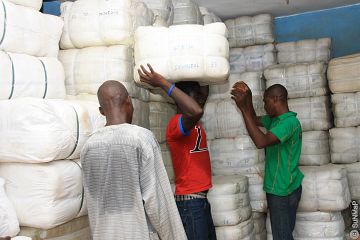New tool to lower the costs of distributing vital insecticide-treated nets for malaria control
30 March 2022
A new cost-effective decision-making tool can be used to quickly map out and prioritise regions for insecticide-treated net (ITN) distribution, especially during public health emergencies and in resource-limited settings. Malaria Consortium researchers were part of a team that developed the tool, their findings were published in BMC Malaria Journal.
“The COVID-19 pandemic challenged vector control distribution campaigns when funding and resources were re-allocated to the early phases of the containment efforts. A simple, rapid, and easily replicable approach for nationwide targeting of malaria interventions was urgently needed,” said Will Eaton of Tulane University School of Public Health and Tropical Medicine, one of the researchers.
Due to vector resistance, the need to use newer types of ITNs and chemicals for indoor residual spraying in malaria control has led to increased vector control costs. Streamlining the selection process of geographical areas where nets are most needed and most effective, lowers costs and supports already overburdened health services in malaria endemic countries during health emergencies, like the COVID-19 pandemic.
“Our aim was to develop a practical, data-driven mechanism for prioritising geographical areas for mass distribution of ITNs amidst a public health emergency and in situations of limited resources. When resources are scarce, choices have to be made. Appropriate prioritisation of areas to target with malaria vector control requires taking account of multiple factors. An approach that helps malaria control programmes to make rational decisions regarding where to deploy interventions first is essential in the face of increasing costs of effective tools,” said Tarekegn Abeku, Senior Technical Specialist – Disease Prevention, Malaria Consortium.
The researchers used widely available data from various sources, including national malaria control strategic plans, ITN operational plans, vector control coverage data and entomological and epidemiological reports.
A method was applied that used weighting and quantification of factors relevant to malaria transmission and control to identify areas that should be prioritised for ITN distribution, using Nigeria as a case study. Values of each factor were grouped into different ranks. For each geographic area, the rank value of each factor was multiplied by the weight assigned to it according to its importance. Composite risk scores were then calculated for each area and used to develop prioritisation maps.
“Data-driven, yet practical approaches that consider local and country-specific contexts are vital in ensuring that scarce, but essential malaria control resources are efficiently distributed, especially during public health emergencies. This research was conducted to provide a tool that can be used to achieve just that,” said lead author, Alyssa Young of Tulane University School of Public Health and Tropical Medicine.
This research contributes to efforts to improve evidence-based targeting of vector control that addresses challenges associated with rising costs due to insecticide resistance. Importantly, it presents a framework that can be adapted to a variety of country contexts and applied to a variety of situations requiring prioritisation of areas in a limited time frame, while using a range of indicators that are typically available and systematically collected in countries that experience P. falciparum transmission.
Latest news
- Malaria Consortium honoured by Ugandan government for contribution to combat malaria23rd April 2024
- International summit calls for AMR accountability in public health interventions21st March 2024
- Global SMC community celebrates new milestone at SMC Alliance Annual Meeting in Nigeria6th March 2024
- Scaling up key interventions could halve pneumonia-related childhood mortality13th February 2024
- Malaria Consortium and eGov Foundation join Mozambique’s national malaria programme to digitalise seasonal malaria chemoprevention campaigns8th February 2024
- World’s first malaria vaccine rollout launched in Cameroon22nd January 2024